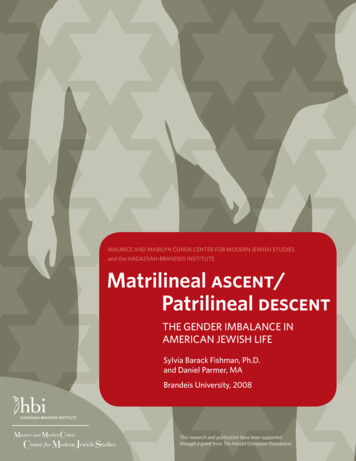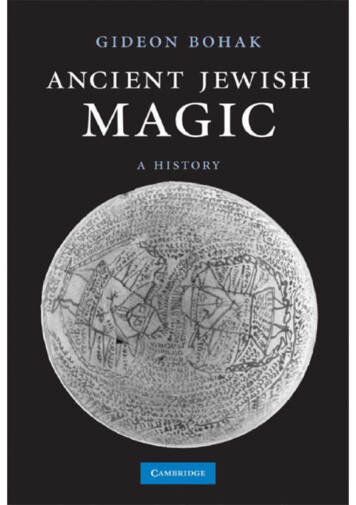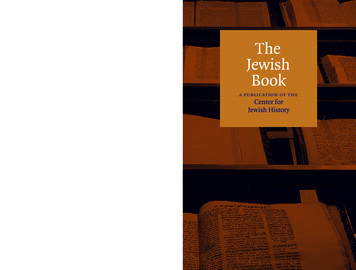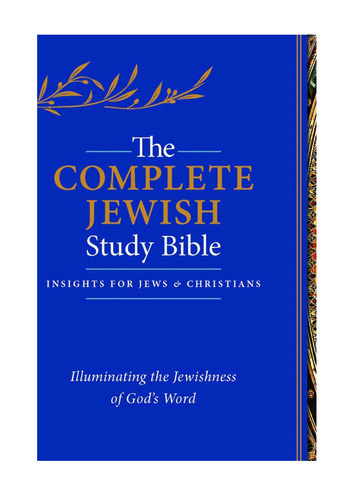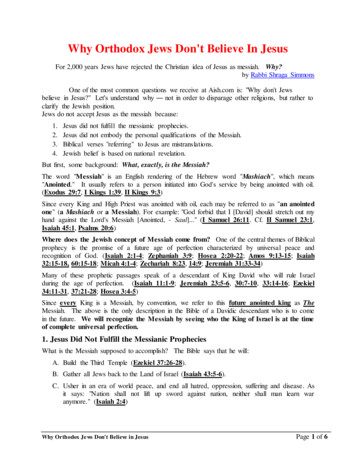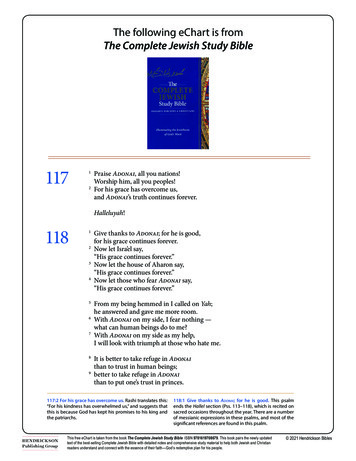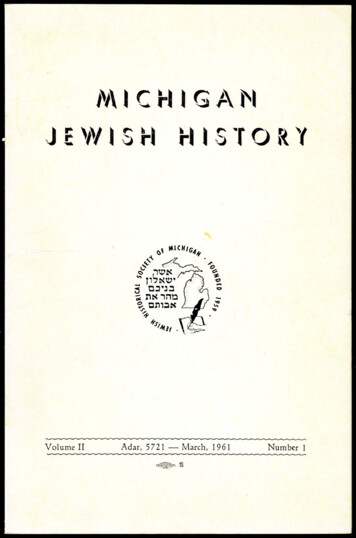
Transcription
MICHIGANJEWISH HISTORYVolume IIA dar, 5721March, 1961Number 1
;18 -int: In p5n,tv4 -1,n3(c:1 vtrri)"When your children shall ask their fathers in time to come . . "Joshua 4:21MICHIGAN JEWISH HISTORYEmanuel Applebaum, EditorVolume IIAdar, 5721March, 1961Number 1Second Lieutenant Raymond Zussman —Congressional Medal of Honor . . . Emanuel Applebaum2Michigan's First and Only JewishCongressman — Hon. Julius HousemanIrving I. Katz 10Detroit Jewish Community'sGenerousity — 1900 - 1960Irving I. Katz12Allen A. Warsen13Cadillac and the Lost Tribes of IsraelBook ReviewsLeonard Moss 17Significant Jewish Anniversaries inMichigan in 1961Irving I. KatzBiographical Notes on Contributors1920The Editors and the Board of Trustees assume no responsibility for opinionsexpressed by contributors.Address all communications to the Editor, Rabbi Emanuel Applebaum, 18632Hartwell Street, Detroit 35, Michigan.1
Second Lieutenant Raymond Zussman,,C. M. H.by EMANUEL APPLEBAUMDuring World War I the total number of men who served inthe armed services of the United States was 4,355,000 men, of whichabout 250,000 were Jewish. It has been estimated that by 1918 thetotal Jewish population in the United States was close to 3,389,000out of a total population of 103,691,000. Therefore, the Jewishpopulation percentage-wise was 3.2%, yet in the armed services thepercentage of Jews was greater, 5.73 %of the total.Again, percentage-wise, in WorldWar II, Jews were only 3.33 % of thetotal population, yet in the services 4.23 %were Jewish, or a total of close to 550,000Jewish men and women who served inall branches of the armed services.During the First World War 3 Jewsreceived the Congressional Medal of Honor. In the Second World War 1 Jew wasawarded this highest award for valor —2nd Lt. Raymond Zussman of Detroit,Michigan.Lt. Raymond ZussmanThe Congressional Medal of Honoris awarded in the name of Congress to an officer, or enlisted man, ofthe armed forces who in actual conflict with the enemy conspicuously distinguishes himself by gallantry and fearlessness at the risk oflife, above and beyond the call of duty. The medal is hung on alight blue ribbon with thirteen white stars.On June 9, 1945 the Congressional Medal of Honor wasawarded posthumously to Second Lt. Raymond Zussman. The presentation was made b-y Major General Charles L. Scott, Commanding General of the Armored Center at Fort Knox, to Mr. NathanZussman, Raymond's elderly father, then 76 years old. Only 292,out of a total of over 10,000,000 men who served in all branchesof the armed services of the United States were given the nation'shighest award for valor — the Congressional Medal of Honor. Sixof these men came from Detroit and Lt. Zussman was one of thesemen.2
LIEUTENANT RAYMOND ZUSSMANLt. Raymond Zussman's parents, Mr. and Mrs. Nathan Zussman had 8 children, four sons and four daughters.Abraham, Henry, David and Raymond (who was the youngest child) , Mrs. Al Luby, Mrs. Jules Wolfson, Miss Bernice andMiss Betty Zussman.Abraham, the eldest son had also been a Captain in the UnitedStates Army and had served during World War I and was woundedin action. Abraham passed away at Dearborn's Veterans' Hospitalonly one week before Raymond was killed in action.The father, Nathan passed away April 9, 1949 at age 84 afterhaving lived in Detroit over 45 years. Nathan had been a soldier inCzarist Russia and had seen action in the Russo-Japanese war.The mother, Rebecca Leah who died in 1938 at age 68, wasborn in Lithuania. She married Nathan before they came to theUnited States at the turn of the century.Being pious orthodox Jews, Mr. and Mrs. Nathan Zussmansaw to it that all their sons and daughters received traditional religious training. They sent their sons to Hebrew school and had provided tutors for them to study Hebrew.Raymond became "Bar Mitzva" at Mishkan Israel Congregation, where he studied Hebrew. He also was in the Synagogue Choir.It had been the fathers wish that his son Henry study for the rabbinate, but circumstances were such that it didn't come about.Raymond the youngest, was considered a bright, good natured,happy-go-lucky youngster by those who knew him, with a greattalent of getting along with all people.He was born July 23, 1917 in his father's home at 9144 JosephCampau, Hamtramck where for over a quarter of a century Mr.Nathan Zussman operated a shoe store. When he was 8 years old thefamily moved to 2511 Glynn Court, Detroit, where they lived whenRay, as many called him, entered the army. He was only 5 feet, 4inches tall and weighed less than 140 pounds. Broad shouldered,healthy, fairly husky and rather fair haired. The family later movedto 2918 Sturtevant in Detroit, where news of Raymond's deathreached them.When he entered the army he thought the war would not listvery long, and that he would not be away for too many years.3
LIEUTENANT RAYMOND ZUSSMAN"You look after Rags" he said to his father as he left (Rags was hispuppy sheep-dog) "he's my pal and he's going to be a great dog."Some six years later Benjamin Glicker, Detroit artist did a memorialportrait of Lt. Zussman and it was reported that when Rags saw theportrait, he ran to it, lay down near it, and would not budge theentire day.Raymond was a graduate of Durfey Intermediate and of CentralHigh School of Detroit. Basketball, tennis and track were what heconsidered his sports, though he would have loved to play footballbut because of his size couldn't make the High School team.He attended night sessions at Wayne University and had alsoattended classes at the Detroit Institute of Technology where hestudied metalurgy.Raymond was 23 years old when he entered the army on September 24, 1941. He first went to Fort Sill, Oklahoma, for basictraining and later to Fort Knox, Kentucky, where he attended theclass of Armored Officers School, from which he graduated as a Second Lieutenant on January 9, 1943. He also served as a tank instructor for 6 months before receiving his commission as Lt. Afterbeing commissioned, he shipped to Africa in June 1943.After he was wounded at Cassino, Italy, and recovered, he wasoffered a Headquarters assignment which he promptly rejected. Heasked for combat duty and was assigned to a tank division, mechanized cavalry, with the 7th army in France. It was for action incombat on September 12, 1944 that he won the nation's highestaward for valor, when in an hour he led in the capture of 92 Germansoldiers and the killing of 18 which resulted in liberating the villageof Noroy L e Bourg in the Rhone Valley. It was in combat. whileresting, that a mortar exploded near him that cost him his life inFrance. He (lied on September 21, 1944 at 26 years of age, nine daysafter the action in battle that won him the Congressional Medal ofHonor posthumously, the highest honor that the United States ofAmerica can bestow on its war heroes.He was also authorized the Purple Heart (posthumous) ; PurpleHeart for wounds received in action on 11 September 1 944 in France;European-African-Middle Fastern Campaign Medal with two BronzeService Stars for the Southern France and Rhineland Campaigns:Good Conduct Medal: American Defense Service Medal: AmericanCampaign Medal: and World War II Victory Medal.—4—
LIEUTENANT RAYMOND ZUSSMANThe Official Army Citation for the Congressional Medal ofHonor reads:Zussman, RaymondRank and organization: Second Lieutenant, 756thTank Battalion. Place and Date: Noroy Le Bourg,France. 12 Sept. 1944. Entered Service at: Detroit,Wt-tiTE HOUSEWASHINGTON.1'he President of the United States takes pride inwarding the MEDAL of HONOR posthumously toSECOND LIEUTENANT RAYMOND ZUSSMAN,CAVALRY, UNITED STATES ARMY:erVici:, as set forth in the followingCITATION:"On 12September 1 ,14, Lieutenant Zussman was in command'of two tanks operating with an infantry company in the attack onnerny forces occupying the town of Noroy le Bourg, France. Athours his co rn mend tank bogged down. Throughout theensuing action, armed only with a carbine, he reconnoitered alonean foot far in advance of his remaining tank and the infantry,returning only from time to time to designate targets, direct theaztion of the tank and turn over to the infantry the numerousGerman soldiers he had caused to surrender. He located a roadblock and directed his tank to destroy it. Fully exposed to firefrom an enemy position only fifty yards distant he stood by histank directing its fire. Three Germans were killed and eightsurrendered, Again he walked before his tank leading it againstan enemy held group of houses, machine gun and small arms firekicking up the dust at his feet. The tank fire broke the resistanceand twenty enemy soldiers surrendered. Going forward againalone he rushed an enemy occupied house from which the Germanefired on him and threw grenades in his path. After a brief firefighthe signaled his tank to come up and fire on the house, ElevenGerman soldiers were killed and fifteen surrendered. Going onalone he disappeared around a street corner, the fire of hiscarbine could be heard and in a few minutes he reappeareddriving thirty prisoners before him, Under Lieutenant Zussman'sheroic and inspiring leadership eighteen enemy soldiers werekilled and ninety two captured,"/qt.Official U. S. Army Citation for the Congressional Medal of Honor awardedposthumously to Lt. Raymond Zussman, signed by President Harry S.Truman. The Medal and Ribbon are alongside.—5
LIEUTENANT RAYMOND ZUSSMANMichigan. Birth: Hamtramck, Michigan. GeneralOrder Number 42, 24 May 1945. Citation: On 12September 1944, Lt. Zussman was in command oftwo tanks operating with an infantry company in theattack on enemy forces occupying the town of NoroyLe Bourg, France. At 7 p.m., his command tankbogged down. Throughout the ensuing action, armedonly with a carbine, he reconnoitered alone on foot farin advance of his remaining tank and the infantry.Returning only from time to time to designate targets,he directed the action of the tank and turned over tothe infantry the numerous German soldiers he hadcaused to surrender. He located a road block anddirected his tank to destroy it. Fully exposed to firefrom an enemy position only 50 y7rds distant, hestood by his tank directing its fire. Three Germanswere killed, eight surrendered. Again he walked before his tank, leading it against an enemy-held groupof houses, machine-gun and small-arms fire kickingup dust at his feet. The tank fire broke the resistanceand 20 enemy surrendered. Going forward againalone he rushed an enemy-occupied house from whichGermans fired on him and threw grenades in his path.After a brief fire fight, he signaled his tank to come upand fire on the house. Eleven German soldiers werekilled and fifteen surrendered. Going or -lone. he disappeared around a street corner. The fire of his carbine could be heard and in a few minutes he reappeared driving 30 prisoners before him. Under Lt. Zussman's heroic and inspiring leadership, 18 enemysoldiers were killed and 92 captured.(From: Medal of Honor, ofricial rubrication of theDepartment of the Army, United States GovernmentPrinting Office, Washington D. C. 1948. page 298)When given his-son's Medal of Honor at the Graduation exercises of the 75th clays of the Officers Candidates School of the Armored School of Fort Knox, Kentucky on June 9, 1945, Mr. NathanZussman in response said:"Major General Scott and Graduates of this Class:It is indeed with great pride that I appear before thisgraduating class, for several years ago, I too, had a sonwho was commissioned in this same training center,6
LIEUTENANT RAYMOND ZUSSMANand I looked to him with great pride just as your parents are looking forward to you for your accomplishments. A pride to think that you have a son dulyqualified to take his just place with our Armed Forces,for a Country which they are so devoted to, for theprotection of the rights which our people stand for.While I have come here with great pride, I still comewith a heavy heart, having given a son for the freedom which I sought, years ago having left a countrywhere the people were oppressed by the yokes of oppression and prejudice, and sought freedom and liberty, which I have enjoyed in this Country for thepast forty-five years.During the Forty-five years that I have enjoyed thefreedom and liberty of this Country, it has made meindeed grateful and proud to think that I have beenable to give a son to this great cause and that he, myson, with his indomitable courage, and with thethought ever in his mind of my leaving a country ofoppression, to seek the freedom of this Country —fought to preserve them and was awarded the highesthonors that could be bestowed by this, Our Country,for his bravery in action.My son, 'Ray,' died just as he always lived, fightingfor what he felt was right, and just."On June 6, 1948, Lt. Zussman was finally laid to rest at theVeterans' Section of Machpellah Cemetery. Nathan Zussman originally had requested a simple, traditional Jewish funeral and ceremony, to be arranged by the Ira Kaufman Memorial Chapel withRabbi Morris Adler officiating. However, Arthur M. Lang, of Detroit, Chairman of the local Jewish War Veterans' Re-burial Committee, explained to the family that it would be fitting for theoccasion to also accord Lt. Zussman military honors, being that hehad been the recipient of the Congressional Medal of Honor.This was arranged at Congregation Shaarey Zedek in the mainsanctuary, where the casket lay in state for 3 hours, flanked by amilitary honor guard. The city of Detroit had wanted to h've thebody lie in state at City Hall, but this the Zussman family had refused to permit. The Department of the Army had wanted to providea caison and a guard to transport the casket from Congregation7
(Photo, Courtesy of Detroit News)the flag-draped casket of Second Lieutena t Raymond Zussman, holder of the Congressional Medal ofHonor, from Congregation Shaarey Zedek after (once! 2r Ee that
LIEUTENANT RAYMOND ZUSSMANShaarey Zedek on West Chicago to Machpelah Cemetery on Woodward and 81/2 Mile Road. All these elaborate plans were refused bythe elderly father, who grieved sorely for his youngest child. Whenthe casket was lowered into the grave close to 1500 pople were present, together with high ranking officers and a military drill team ofthe Charles A. Learned Post Number 1, of the American Legion, andthe Zussman Post of the Jewish War Veterans of America. Airplanes from Selfridge Field flew overhead and dipped their wingsand dropped flowers, as Cantor Sonenklar chanted the traditionalJewish memorial prayers, and the family recited a sacred prayer atthe grave — the Kaddish.In memory of Raymond Zussman a small park was dedicted inHamtramck, Michigan — the locale where he was born. It wouldseem that because Raymond Zussman was Jewish, several neighborhood groups objected. For reasons not clear the park does not, asyet, have a marker stating that it was dedicated in honor of a manwho gave his life in the service of his country.A playground on Davison near Dexter Avenue, adjacent to theDexter-Davison Jewish Community Center is dedicated to his memory, and a Detroit Post of the Jewish War Veterans of the UnitedStates bear his name — The Lt. Raymond Zussman Post No. 333.An Army Transportation Corps freight supply vessel, or, aseagoing trawler, was named in his honor "The Lieutenant RaymondZussman."In the Library of the Jewish Community Center — DexterDavison Division, a memorial portrait of Lt. Zussman was hung.This portrait was the one that was painted by Ben'amin Glickerof Detroit.(The author wishes to express his appreciation to Mrs. Ruth P. Braun, chiefLibrarian of the Detroit News; and to Colonel Eugene S. Tarr. A.G.C. of the officeof the Adjutant General, U. S. Army Records, St. Louis. Missouri, for officialrecords, and biographical notes which were made available and which were mosthelpful.)9
Hon. Julius Houseman - Michigan'sFirst and Only Jewish Congressmanby IRVING I. KATZThe first Jewish resident of Michigan to have been elected tothe Congress of the United States was Julius Houseman of GrandRapids.He was born at Zeckendorf, Bavaria, Germany, December 8,1832. His father, Solomon Houseman, a native of Bavaria, was amerchant and manufacturer of silk and cotton goods at Zeckendorf,where he died in 1873 at the age of 71. His mother, Henrietta,daughter of Julius Strauss of Heiligenstadt,Bavaria, died in 1835 at the age of 35.Julius was the older of two children, hissister, Mary, having married Albert Alsberg, a prominent New York merchant.Houseman's education, up to the ageof 13, was obtained in the NationalSchools of Zeckendorf and Bamberg, andwas completed with a two years' commercial course, after which he was a dry goodsclerk.CAME TO U. S. IN 1851The Revolution in Germany in 1848had its influence on the young man's life.Hon. Julius HousemanIn 1851, at 19, he left to seek freedom inthe United States. His first home was in Cincinnati, where he wasa clerk in a clothing house.Then he went to New Vienna, Ohio, wherehe remained as clerk in a general storeuntil March, 1852, when hecame to Battle Creek, Michigan. Here he engaged in the merchanttailoring business with Isaac Amberg, the firm name being AmbergHouseman.In August, 1852, he came to Grand Rapids, the first Jewishsettler in that city which then had a population of less than 3,000.He established a branch of the Battle Creek firm and in 1854 became its sole proprietor.HIS BUSINESS SUCCESSESIn 1864, the firm of Houseman, AlsbergCo. was organized,with branches in New York, Baltimore, and Savannah, which con10
MICHIGAN'S FIRST AND ONLY JEWISH CONGRESSMANtinued until 1870, when the firm was dissolved, Mr. Housemanretaining possession of the Grand Rapids establishment. In 1870,Houseman spent a summer in Europe, visiting Germany, Switzerland,France and England. In 1876, he disposed of his business to hiscousin, Joseph Houseman, who had been a partner for several yearsand who was also a prominent Jewish resident of Grand Rapids;and Moses May, who continued it for a number of years under thefirm name of Houseman May, later succeeded by Houseman,Donnally and Jones. The business, today the second oldest mercantile establishment in Grand Rapids, still located on Monroe Street,goes by the name of Houseman Jones.Houseman had meanwhile taken an active interest in other linesof business and investments, notably in timber lands and the manufacture of pine lumber in Michigan, and after 1876 devoted himselflargely to these interests.The Houseman Building in Grand Rapids, one of the largestbusiness blocks in the state, is a fitting monument to him.In 1870, he became a stockholder in the City National Bank,the predecessor of the National City Bank. He was an organizer ofthe Grand Rapids Chair Company, director of the Grand RapidsBrush Company, and president of the Grand Rapids Fire InsuranceCompany.In political affiliations, Houseman was a Democrat. He servedas Alderman in Grand Rapids for eight years, from 1863 to 1870,was Mayor in 1872 and in 1874, and represented Grand Rapids inthe State Legislature in 1871-72.ELECTED TO CONGRESSIn 1876 he was the candidate of his party for Lt. Governor ofthe State. He was proposed for the Governorship of Michigan, butrefused to be a candidate. In 1883 he was elected to represent theFifth District of the State of Michigan in the 48th Congress and wasthe first and only Jewish Congressman from Michigan.Houseman was a loyal and devoted Jew and took a leadingand active interest in the affairs of the Jewish community of GrandRapids. He was one of the incorporators of Temple Emanuel, in1871, and served as its first president. He was one of the organizersof Grand Rapids Lodge 238, B'nai B'rith. in 1875, and served asits first president. When Houseman died in Grand Rapids on Feb.9, 1891, at the age of 59, the Lodge's name was changed in tributeto his memory, to Julius Hous.?tnan Lodge. a name under which itfunctions to this day.
DETROIT JEWISH COMMUNITY'S GENEROSITY1900 -1960.by IRVING I. KATZUNITED JEWISH 906190719081909191019111912 . 87014,94218,18821,966Number 489Year1913 924*1925AmountRaisedNumber ofContributors 24,49729,10734,333534608660150,4002,794* Unavailable at presentALLIED JEWISH CAMPAIGN OF JEWISH WELFAREFEDERATIONYearAmountRaisedNumber ofContributors3,1851926 (a) 713,374390,732193819,080651,8891939735,970 01943(War Chest)960.0001944(War Chest)YearAmountRaisedNumber ofContributor.; 1,135,940(War Chest)22,1201946 (b) 5.95819575,918,16224,57 101945.(a) Funds were raised for a three-year period - 1926. 1927, 1928.(b) Includes 912,091 from the War Chest Campaign conducted by the Community Chest of Detroit.12
Cadillac and the Lost Tribes of Israelby ALLEN A. WARSENIn II Kings, chapter 17, the Bible records: "In the ninth yearof Hoshea, the king of Assyria took Samaria, and carried Israel untoAssyria . . . unto this day." 1)And unto this day people have been speculating about the fateand whereabouts of the "carried away" Samarians. Thus Jewishlegend has it that the lost tribes of Israel continue to live in theregions of the legendary river Sambationwhich is said to flow six days and reston the seventh.Other people, however, formed different conceptions and created . differenttheories as to the identity of the lost tribesof Israel. Cadillac, the founder of Detroit,was an adherer of the theory that theAmererican Indians were the descendantsof the ancient Jews. His views he expressed in a document dated 1718 and entitled "Description of Michilliamackinac:Indian Tribes of that Region." 2)In this document, among other de- Cadillac believed that thescriptions, Cadillac describes the Indianpractice of nose piercing as follows: " . . Indians were the descendantsthe word Outaous means in our language of the Ten Lost Tribes."the Nation of the Nez Percez" (pierced noses) , to which they attach a small stone well ornamented, which hangs down in the middleof the mouth between the lips. This is a custom among them, andthey would not consider themselves properly adorned without thisornament. Some of the elders maintain, however, that it is a preventive against "medicine" — that is to say, the spells that theirenemies and their evil-intentioned persons might cast upon them, topoison them or cause their death."1) The I-10!y Scriptures, The Jewish Publication Society of America (Philadelphia.5677-1917).2) Cadillac's references to Indian origins are published in Pierre Margry'sDecouvertes et Etablissments des Fracais (Paris, 1876-1886), v.5, and repubI:shed in translation in Collections of the State Historical Society of Wisconsin.v. 16, Madison, 1902). pp. 358-359 and 363.I am indebted to Mr. James M. Babcock, Chief Burton Historical Collection.Detroit Main Library. for helping me locate the above publication.13
CADILLAC AND THE LOST TRIBES OF ISRAELThis practice, Cadillac, mainained, was proof "that it is anidea of the ancient Jews; for we read in history that one Eleazardelivered people possessed of the devil, in the presence of the Emperor Vespasian, of his son, and of several princes and noblemen of hiscourt. He proceeded as follows: he pierced the nose of the possessedone, and passed through it a ring hollow inside, wherein he placedan herb ; and as soon as the devil smelled it, he threw the body ofthe possessed one upon the ground, and fled, without daring to return to it. The same Eleazar also did this frequently in the name ofSolomon; so that these savage nations may well have retained thiscustom of piercing their noses, and have forgotten the purpose forwhich it was introduced."As further proof that the American Indians were the descendants of the lost tribes of Israel, Cadillac presents the following evidence: "There is a place near Missilmakinak, called Essolon . . . Iinquired of some savages the reason it (the name) had been givento the place; they replied that their ancestors had given it that name. . . Thereupon we may recall that Reuben had four sons: Henoch,Hesron, Phallus, and Cormi. How could the savages have given theriver the name of Essolon, if they had never heard of it? It is notlikely that this was done by accident, but rather because it was thecustom of the Jews to bear the names of their estates, or to give theirown names to property of which they were in possession."The following habit of the Indians, Cadillac believes, is additional evidence of the Indians' Jewish descent: " . . . it seldomhappens that a Sioux is taken alive; because, as soon as they see thatthey can no longer resist, they kill themeslves, considering that theyare not worthy to live, when once bound, vanquished, and madeslaves. It is rather surprising that people so brave and so warlike asthese should nevertheless be able to shed tears at will, and so abundantly that it can hardly be imagined. I think that it could not bebelieved without being seen: for they are sometimes observed tolaugh, sing, and amuse themselves when, at the same time, one wouldsay that their eyes are like gutters filled by a heavy shower; and assoon as they have wept, they again become as joyful as before,whether their joy be real or false. The chief occasion of their tearsis when their enemies have killed some of their people; thereupon,they address themselves to their allies . . . Bending their heads theyutter horrible yells, and shed a deluge of tears, after which theycease to weep and yell, and their eyes are as dry as if they had notwept. They afterward represent the state of their affairs, so that14
CADILLAC AND THE LOST TRIBES OF ISRAELone may say that they are the same Jews who dwelt on MountGerisim, 3) who were called "Mourners," because they had the giftof tears."At this point it should be noted that Cadillac was not the originator or the final expounder of the theory that the Indians are thedescendants of the lost tribes of Israel. In all likelihood the Spanishpriests who migrated to America after it had been discovered byColumbus were the first to suggest it. 4) It was soon espoused by thehistorian Las Casas, 5 ) a contemporary of Colombus, known as theapostle of the Indians, and by F. Lumnius in his De extremo DeiJudicio et indorum vocatione, libri iii (1569). 6)Even Mansseh Ben Israel, the Dutch rabbi who persuaded OliverCromwell to readmit the Jews to England, advocated it in his bookOrigen de los Americanos (1650). 7) He based the advocacy of thistheory on the assertions of a certain Montesinos who claimed to havediscovered a Jewish settlement in Peru.Other protagonists of this theory were such outstanding NewEngland divines as Cotton Mather's) and Roger Williams, the founder of Rhode Island. In 1697 Samuel Sewall championed it in hisPhaenomena qaedam Apocalyptica ad aspectum Novi Orbis Con figurata. 1 )Mordecai Manuel Noah, the first American Zionist and thefounder of the Jewish state of Ararat on Grand Island near NiagaraFalls, proclaimed this theory in his discourse on The Evidences of theAmerican Indians Being the Descendants of the Lost Tribes of Israel(1837) . 11 )Again in 1908 "convincing proof" was offered in its supportin a treatise entitled "The Mound Builders and the Lost Tribes. " 1 ')The following excerpts from this paper are quite illuminating:"According to the new hypothesis, the tribes reached the western hemisphere by way of an isthmus believed to have existed wherethe narrow waters of Behring Strait now divide the continents. GivGerizim, a mountain in Ephraim, has since ancient times been the sacred placeof the Samaritans.4) Justin Winsor, Narrative and Critical History of America, v.1 (Boston andNew York, 1889) , p. 115.5) , 6) , 7) , 8) , 9) , 10) Ibid., loc. cit.11) The Universal Jewish Encyclopedia, v.8 (New York, 1942) , p. 227.12) Ohio Archaeological and Historical Publications. v.17.3)15
CADILLAC AND THE LOST TRIBES OF ISRAELing color of truth to this theory is the fact that ethnologists whohave sojourned among the natives inhabiting the great region southand east of Behring Strait assert that many Greek and Hebrew wordsare distinguishable in the language employed by the natives of thatregion today."More proof follows: "Near the town of Jackstown (Ohio) ,there was a mound about 80 feet in height and 500 feet around thebase . . . After the mound had been demolished until only the foundation remained two of the laborers discovered and examined a pairof copper rings found lying on what appeared to be a slab . . . Onremoving the slab . . they found it to be covering a trough-shapedbox . . . Underneath the box was a heavy deposit of fireclay. Diggingin this clay they found an oblong box containing something thatgave forth a rattling sound . . . In the box was found a curiousstone . . . On one side a depression was cut, and in that depressionwas an image representing a man with a flowing beard, sandaled feet,with robe and staff, and under the figure appeared an inscription . .The Rev. Mathew Miller, then a resident of Cumberland, Ohio, atonce pronounced the relic a Jewish teraphim. He declared the imagethereon was Moses and the characters interpreted, were the ten commandments . . . To make sure that his interpretation was correct,the Rev. Miller took the relic to Cincinnati and there consulted Dr.Lillienthal, who was then considered the most learned rabbi in theUnited States. He coinci
Michigan's First and Only Jewish Congressman Hon. Julius Houseman Irving I. Katz 10 Detroit Jewish Community's Generousity 1900 - 1960 Irving I. Katz 12 Cadillac and the Lost Tribes of Israel Allen A. Warsen 13 Book Reviews Leonard Moss 17 Significant Jewish Anniversaries in Michigan in 1961 Irving I. Katz 19
